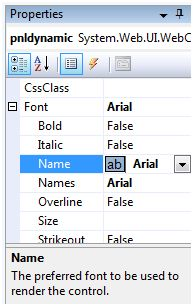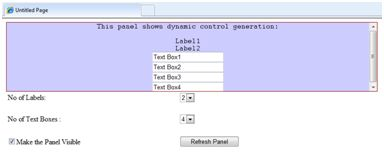ASP.NET Panel control
May 13, 2021 ASP.NET
Table of contents
Panel control
Panel controls can be containers for other controls on a page. I t controls the appearance and visibility of the controls it contains. It also allows the build control to be programmed.
The basic syntax of panel controls is as follows:
<asp:Panel ID= "Panel1" runat = "server">
</asp:Panel>Panel controls are derived from the WebControl class. T herefore, it inherits all the properties, methods, and events as well. I t does not have any methods or events of its own. However, it has its own following properties:
| Property | Describe |
|---|---|
| BackImageUrl | The address of the panel background image. |
| DefaultButton | Gets or sets the identifier of the default button contained in the Panel control. |
| Direction | The orientation of the text in the panel. |
| GroupingText | Allows text to be grouped as a field. |
| HorizontalAlign | Align the contents of the panel horizontally. |
| ScrollBars | Specifies the visibility and position of the scroll bar within the panel. |
| Wrap | Allow text to line. |
Use panel controls
Let's start with a simple scroll panel with a specific height and width and border style. The scroll bar property is set to two scroll bars, so both scroll bars are rendered at the same time.
The source file has the following panel label code:
<asp:Panel ID="Panel1" runat="server" BorderColor="#990000" BorderStyle="Solid"
Borderstyle="width:1px" Height="116px" ScrollBars="Both" style="width:278px">
This is a scrollable panel.
<br />
<br />
<asp:Button ID="btnpanel" runat="server" Text="Button" style="width:82px" />
</asp:Panel>The panel is rendered as follows:

Example
The following example demonstrates dynamic content generation. T he number of label controls and text boxes that the user provides to be generated on the panel. Control is programmatically generated.
Use the property window to change panel properties. When you select a control in design view, the properties of a particular control are displayed in the property window and allow you to change it without typing.

The source file for the example is as follows:
<form id="form1" runat="server">
<div>
<asp:Panel ID="pnldynamic" runat="server" BorderColor="#990000"
BorderStyle="Solid" Borderstyle="width:1px" Height="150px" ScrollBars="Auto" style="width:60%" BackColor="#CCCCFF" Font-Names="Courier" HorizontalAlign="Center">
This panel shows dynamic control generation:
<br />
<br />
</asp:Panel>
</div>
<table style="width: 51%;">
<tr>
<td class="style2">No of Labels:</td>
<td class="style1">
<asp:DropDownList ID="ddllabels" runat="server">
<asp:ListItem>0</asp:ListItem>
<asp:ListItem>1</asp:ListItem>
<asp:ListItem>2</asp:ListItem>
<asp:ListItem>3</asp:ListItem>
<asp:ListItem>4</asp:ListItem>
</asp:DropDownList>
</td>
</tr>
<tr>
<td class="style2"> </td>
<td class="style1"> </td>
</tr>
<tr>
<td class="style2">No of Text Boxes :</td>
<td class="style1">
<asp:DropDownList ID="ddltextbox" runat="server">
<asp:ListItem>0</asp:ListItem>
<asp:ListItem Value="1"></asp:ListItem>
<asp:ListItem>2</asp:ListItem>
<asp:ListItem>3</asp:ListItem>
<asp:ListItem Value="4"></asp:ListItem>
</asp:DropDownList>
</td>
</tr>
<tr>
<td class="style2"> </td>
<td class="style1"> </td>
</tr>
<tr>
<td class="style2">
<asp:CheckBox ID="chkvisible" runat="server"
Text="Make the Panel Visible" />
</td>
<td class="style1">
<asp:Button ID="btnrefresh" runat="server" Text="Refresh Panel"
style="width:129px" />
</td>
</tr>
</table>
</form>The source code Page_Load responsible for dynamically generating the control behind the event is:
public partial class _Default : System.Web.UI.Page
{
protected void Page_Load(object sender, EventArgs e)
{
//make the panel visible
pnldynamic.Visible = chkvisible.Checked;
//generating the lable controls:
int n = Int32.Parse(ddllabels.SelectedItem.Value);
for (int i = 1; i <= n; i++)
{
Label lbl = new Label();
lbl.Text = "Label" + (i).ToString();
pnldynamic.Controls.Add(lbl);
pnldynamic.Controls.Add(new LiteralControl("<br />"));
}
//generating the text box controls:
int m = Int32.Parse(ddltextbox.SelectedItem.Value);
for (int i = 1; i <= m; i++)
{
TextBox txt = new TextBox();
txt.Text = "Text Box" + (i).ToString();
pnldynamic.Controls.Add(txt);
pnldynamic.Controls.Add(new LiteralControl("<br />"));
}
}
}When executed, the panel is rendered as:
